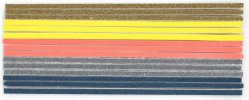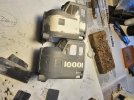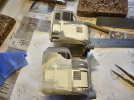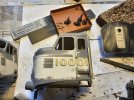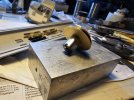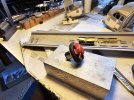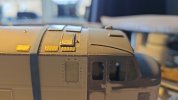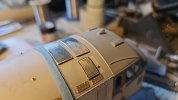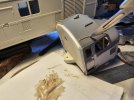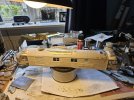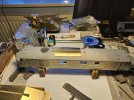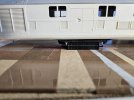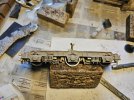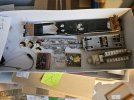Nick Dunhill
Western Thunderer
Several others have posted threads on building this kit, but I thought I'd do a quick overview of my take on it.
The client wanted the engine bay doors on the roof modifying to represent the loco as built in 1948. There were a host of mods to the roof,
(boiler room chimney and vent etc) and some to the cab moulding that I'll come to later.
The engine bay doors are assymetric, and not as cast on the moulding. I pondered how to achieve this for ages. I am conscious that if you scar the surrounding areas with the cutter of your choice, it'll be hard to repair. I decided to cut the roof sections away leaving only small areas to be reduced/sanded.
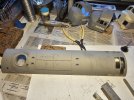
I made all the replacement panels from brass sheet, as that's where my expertise is.
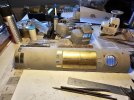
Here's the modified roof. The new access doors make a difference I think.
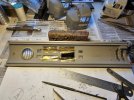
Not so pretty underneath!
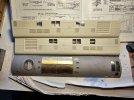
The body sides only needed some flush screw witness marks. I used a short length of 0.6 mm thin walled tube in a pin chuck to make the indentations. I also scored some panel joins in the tumblehomes, and on the roof.
The cab mouldings have a panel on each side, in front of the number, that is raised but should be flush. I have bought some emery sticks to have a go at them on tuesday after the Bank Hol break. I have to confess I am a bit apprehensive about carrying the mod out. I'm fearful of damaging the surrounding area.
Looks ok so far though...
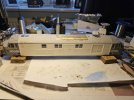
The client wanted the engine bay doors on the roof modifying to represent the loco as built in 1948. There were a host of mods to the roof,
(boiler room chimney and vent etc) and some to the cab moulding that I'll come to later.
The engine bay doors are assymetric, and not as cast on the moulding. I pondered how to achieve this for ages. I am conscious that if you scar the surrounding areas with the cutter of your choice, it'll be hard to repair. I decided to cut the roof sections away leaving only small areas to be reduced/sanded.

I made all the replacement panels from brass sheet, as that's where my expertise is.

Here's the modified roof. The new access doors make a difference I think.

Not so pretty underneath!

The body sides only needed some flush screw witness marks. I used a short length of 0.6 mm thin walled tube in a pin chuck to make the indentations. I also scored some panel joins in the tumblehomes, and on the roof.
The cab mouldings have a panel on each side, in front of the number, that is raised but should be flush. I have bought some emery sticks to have a go at them on tuesday after the Bank Hol break. I have to confess I am a bit apprehensive about carrying the mod out. I'm fearful of damaging the surrounding area.
Looks ok so far though...


 .
.